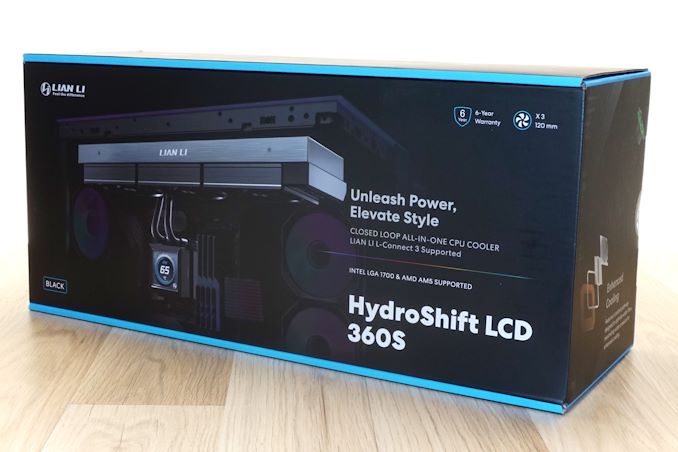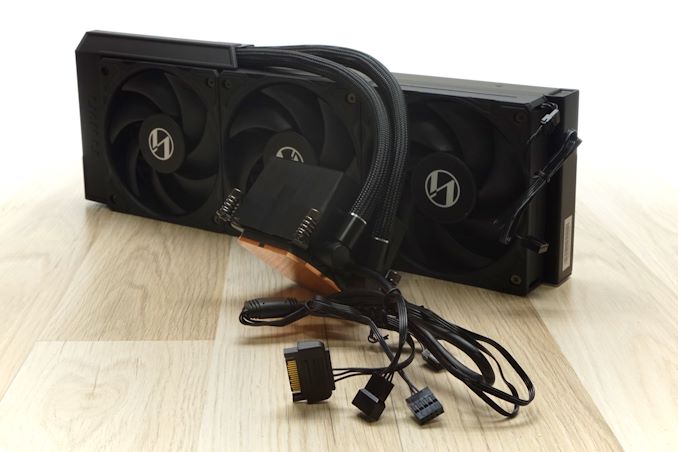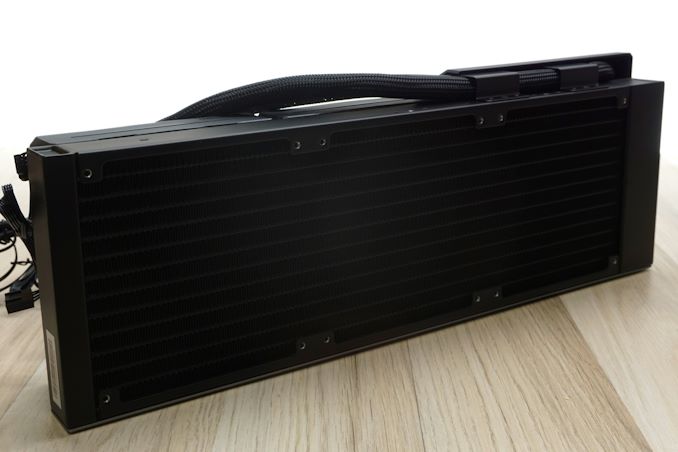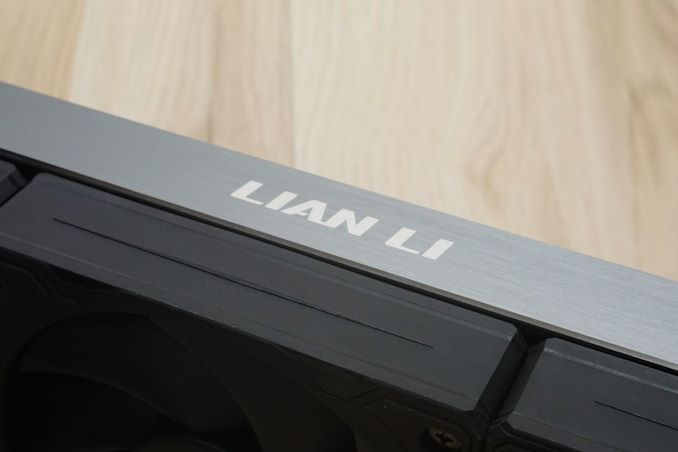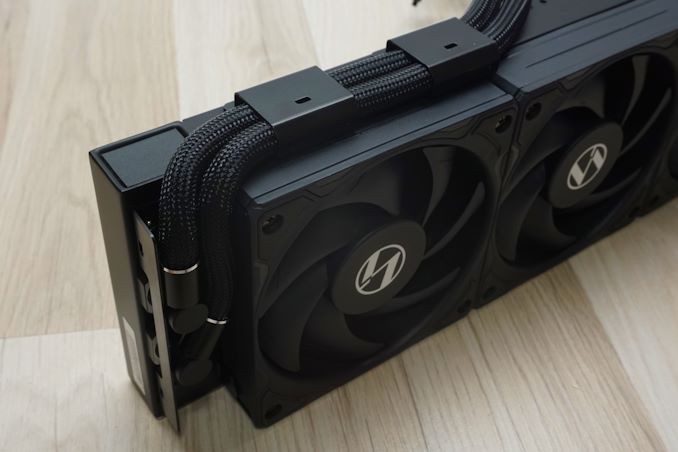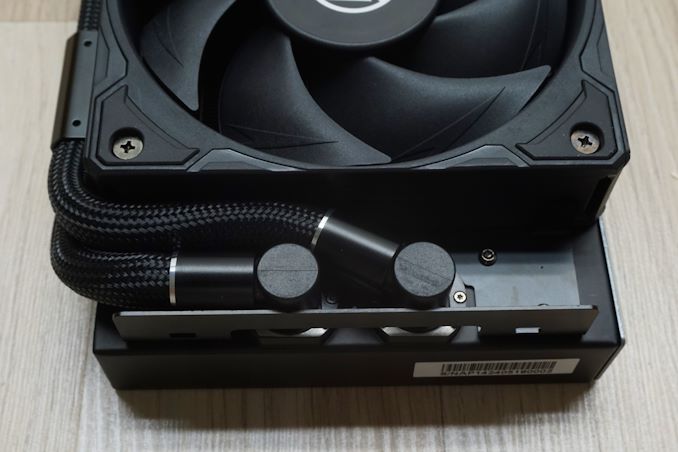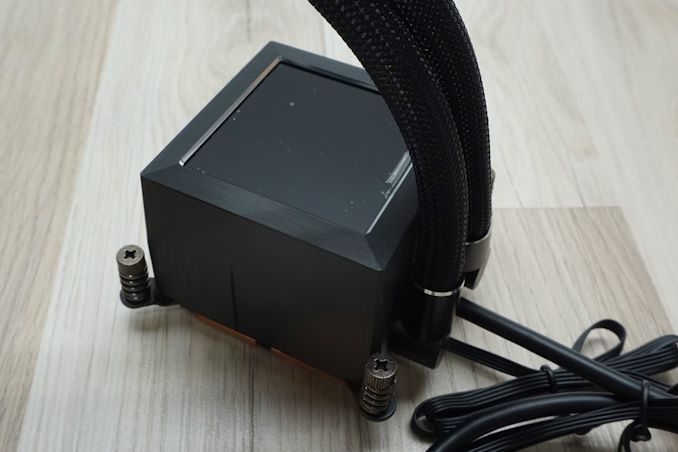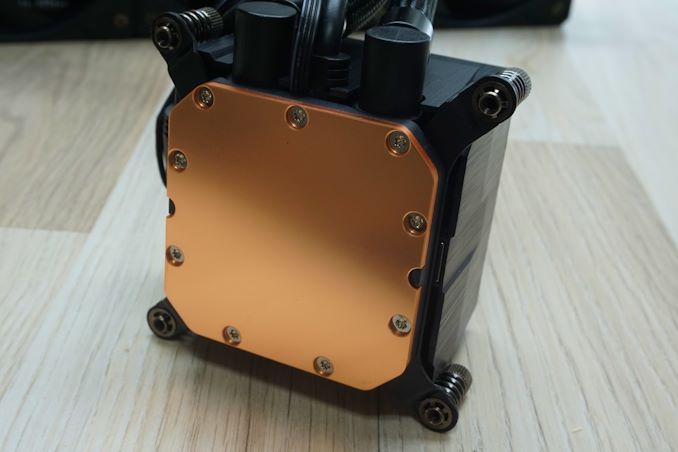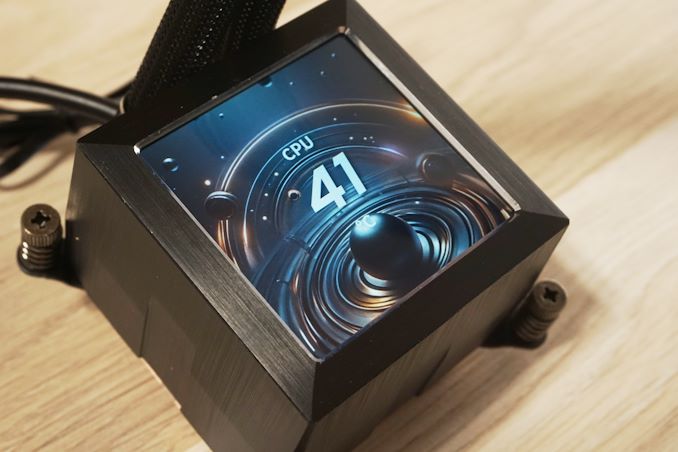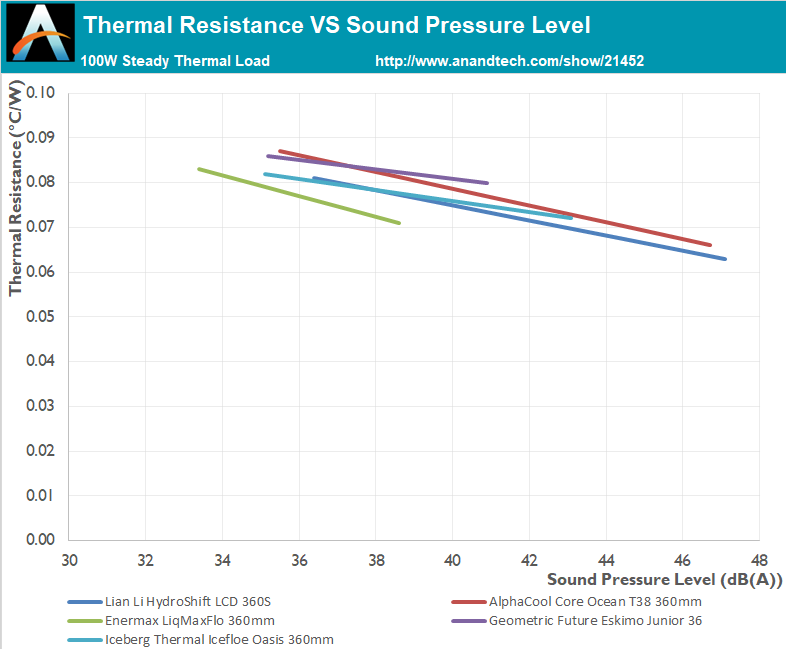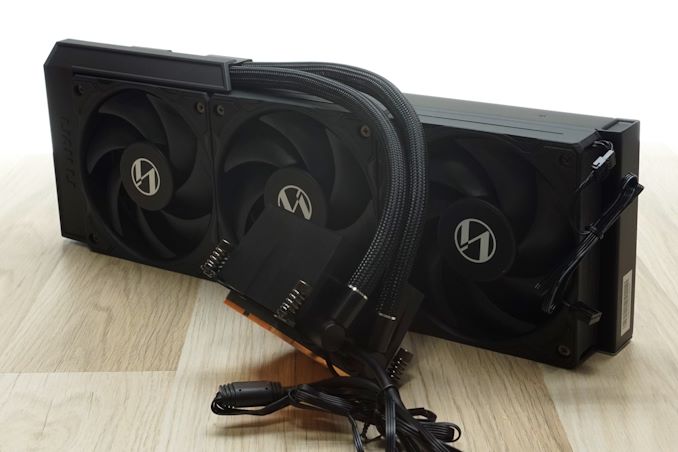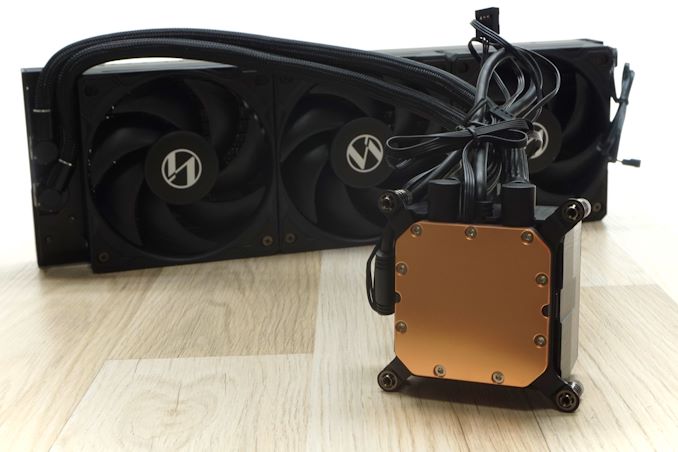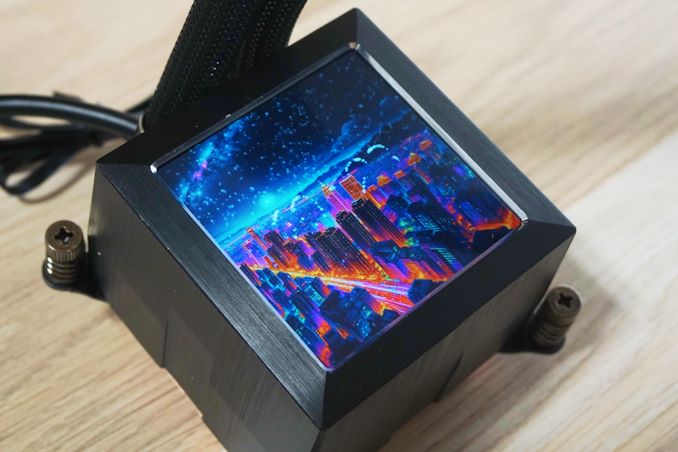Among the packed field of PC hardware manufacturers, Lian Li is a company that arguably shouldn’t even need an introduction. The quirky company has developed a devout following thanks to its focus on premium-quality aluminum computer cases that, more often that not, and come with in some rather unique designs. Over the years, the company has developed a solid reputation for its meticulous craftsmanship, durability, and elegant aesthetics. And consequently, when the company made the decision to expand beyond aluminum cases and in to other PC peripherals, that development attracted quite a bit of attention to see what kind of a touch Lian Li could bring to the rest of the PC ecosystem.
Lian Li’s focus on premium products means that the company doesn’t really make much in the way of products that are merely basic, and that kind of mentality has extended beyond cases and into the rest of their peripherals. Case in point is the subject of today’s review: Lian Li’s new all-in-one CPU cooler, the HydroShift LCD 360S AIO. Not content just to make a powerful 360 mm cooler, Lian Li has gone a step above by integrating recesses and other features to help hide the tubing around the cooler, and then for the coup de grace, added a high-quality 2.88-inch IPS display to the pump block.
Overall, this new product marks a significant milestone for Lian Li, as it combines advanced cooling technology with the company’s signature aesthetic appeal, making for a cooler that’s aimed at both enthusiasts and professional users seeking high-end thermal performance and visual customization. Overall, the HydroShift LCD 360S is undeniably designed first and foremost with aesthetics in mind, but the shiny pump block is backed up with one of the most powerful 360 mm cooler designs on the market today. So Lian Li is throwing everything they have at the new HydroShift coolers.
Overall, the 360S is part of a trio of HydroShift 360 mm coolers the company is launching this summer. All three share a similar design, although with some pump changes and the addition of RGB fan lighting, depending on the specific model, with the 360S effectively serving as the base model.
| Lian Li HydroShift 360S AIO CPU Cooler Specifications |
|||
| Type | All-in-One Liquid Cooler | ||
| Dimensions | 403 x 124.5 x 52 mm (radiator with fan) | ||
| Fans | 3 x 120 mm Fluid Dynamic Bearing Fans 2500 RPM (max) |
||
| RGB | No | ||
| Display | 480px x 480px IPS LCD (500 nits) | ||
| Supported Sockets | Intel: LGA1700
AMD: AM5 / AM4 |
||
| Warranty | 6 Years | ||
| Price | $180 | ||
Lian Li supplies the HydroShift LCD 360S in a black cardboard box with blue accents. The image on the box is trying to focus on the “tubeless” aesthetic and LCD screen, which are the major marketing points of this cooler. Custom cardboard inserts protect the cooler inside the packaging, ensuring safe shipping.
Aside from the necessary mounting hardware, we also found several plastic parts bundled with the cooler, all of which are meant to improve aesthetics. There is a right-side tube cover, which can be used to replace the left-side cover that is already installed on the cooler, plus some tube/wire guides for a clean final look.
At first glance, the Lian Li HydroShift LCD 360S AIO CPU cooler looks a great deal like many of the typical 360 mm AIO coolers already on the market. This cooler adheres to the typical AIO structure, featuring a substantial radiator, dual hoses, and an integrated pump-block assembly. The pump-block incorporates a copper coldplate for direct CPU contact and an efficiently designed liquid pump, representing the conventional setup for AIO coolers. Lian Li employs durable rubber hoses wrapped in braided sleeving for enhanced protection, which are remarkably flexible despite their multiple layers.
The Lian Li HydroShift LCD 360S AIO features a radiator that is 27 mm thick, the standard thickness for AIO cooler radiators, which ensures its compatibility with almost any case designed to accommodate a 360 mm radiator. The radiator design utilizes the typical dual-pass cross-flow configuration, with small fins attached to thin, elongated tubes for efficient heat dissipation.
What is different than most other AIO designs are that Lian Li added metallic braces that secure the tubes, as well as a plastic cover for them. The concept is that, once installed, the tubes will be mostly hidden behind the radiator, against the right side of the case. On the other side of the radiator, Lian Li installed an aluminum plate with the company’s logo on it. This aluminum plate is removable and can be installed on either side of the radiator and in any orientation.
The main block of the Lian Li HydroShift LCD 360S AIO is an aluminum square that with a copper coldplate at its bottom and a liquid pump hidden inside it. Every HydroShift cooler has a different pump, and the 360S has the fastest – but not the most powerful – pump of the entire series to this date. It features metal hose 90° connectors with nickel edges. Although it looks very plain when unpowered, the main block features an LCD display for real-time system monitoring and customizable visual effects. Two cables exit the assembly, one for powering the pump and one that connects to a USB header and is meant to control the LCD screen.
The underside of the main block assembly of the Lian Li HydroShift LCD 360S AIO cooler features a octagonal-shaped contact plate secured to the body with nine screws. While the surface of the plate is not mirror-polished, it is sufficiently smooth and flat for efficient thermal transfer. The cooler does not come with pre-applied thermal paste; instead, the company includes a syringe of thermal compound for application during installation. The dimensions of the coldplate are approximately 60×60 mm, ensuring it covers the entirety of the CPU dies it is compatible with.
The standout feature of the Lian Li HydroShift LCD 360S AIO is its advanced IPS LCD screen, which is integrated into the main block assembly. The 2.88-inch, 480×480 pixel screen is fully customizable, enabling users to personalize the display with custom graphics, animations, or detailed system information. It can offer real-time monitoring of essential system parameters, such as CPU temperature, CPU wattage, and pump speed, providing users with immediate feedback on their system’s performance. The LCD screen’s vibrant and clear visuals – as well as a peak brightness that we’re told can hit 500 nits – add a striking visual element to the cooler, making it a focal point in any vibrant PC build. It could also be said that it has a functional side too if the PC case is placed in such a way that the user can turn to the LCD screen for real-time information.
Although the testing of a cooler appears to be a simple task, that could not be much further from the truth. Proper thermal testing cannot be performed with a cooler mounted on a single chip, for multiple reasons. Some of these reasons include the instability of the thermal load and the inability to fully control and or monitor it, as well as the inaccuracy of the chip-integrated sensors. It is also impossible to compare results taken on different chips, let alone entirely different systems, which is a great problem when testing computer coolers, as the hardware changes every several months. Finally, testing a cooler on a typical system prevents the tester from assessing the most vital characteristic of a cooler, its absolute thermal resistance.
The absolute thermal resistance defines the absolute performance of a heatsink by indicating the temperature rise per unit of power, in our case in degrees Celsius per Watt (°C/W). In layman’s terms, if the thermal resistance of a heatsink is known, the user can assess the highest possible temperature rise of a chip over ambient by simply multiplying the maximum thermal design power (TDP) rating of the chip with it. Extracting the absolute thermal resistance of a cooler however is no simple task, as the load has to be perfectly even, steady and variable, as the thermal resistance also varies depending on the magnitude of the thermal load. Therefore, even if it would be possible to assess the thermal resistance of a cooler while it is mounted on a working chip, it would not suffice, as a large change of the thermal load can yield much different results.
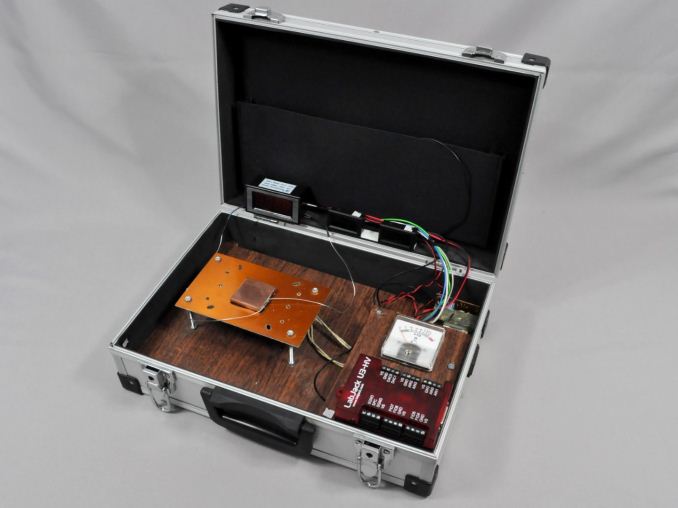
Appropriate thermal testing requires the creation of a proper testing station and the use of laboratory-grade equipment. Therefore, we created a thermal testing platform with a fully controllable thermal energy source that may be used to test any kind of cooler, regardless of its design and or compatibility. The thermal cartridge inside the core of our testing station can have its power adjusted between 60 W and 340 W, in 2 W increments (and it never throttles). Furthermore, monitoring and logging of the testing process via software minimizes the possibility of human errors during testing. A multifunction data acquisition module (DAQ) is responsible for the automatic or the manual control of the testing equipment, the acquisition of the ambient and the in-core temperatures via PT100 sensors, the logging of the test results and the mathematical extraction of performance figures.
Finally, as noise measurements are a bit tricky, their measurement is being performed manually. Fans can have significant variations in speed from their rated values, thus their actual speed during the thermal testing is being recorded via a laser tachometer. The fans (and pumps, when applicable) are being powered via an adjustable, fanless desktop DC power supply and noise measurements are being taken 1 meter away from the cooler, in a straight line ahead from its fan engine. At this point we should also note that the Decibel scale is logarithmic, which means that roughly every 3 dB(A) the sound pressure doubles. Therefore, the difference of sound pressure between 30 dB(A) and 60 dB(A) is not “twice as much” but nearly a thousand times greater. The table below should help you cross-reference our test results with real-life situations.
The noise floor of our recording equipment is 30.2-30.4 dB(A), which represents a medium-sized room without any active noise sources. All of our acoustic testing takes place during night hours, minimizing the possibility of external disruptions.
| <35dB(A) | Virtually inaudible |
| 35-38dB(A) | Very quiet (whisper-slight humming) |
| 38-40dB(A) | Quiet (relatively comfortable – humming) |
| 40-44dB(A) | Normal (humming noise, above comfortable for a large % of users) |
| 44-47dB(A)* | Loud* (strong aerodynamic noise) |
| 47-50dB(A) | Very loud (strong whining noise) |
| 50-54dB(A) | Extremely loud (painfully distracting for the vast majority of users) |
| >54dB(A) | Intolerable for home/office use, special applications only. |
*noise levels above this are not suggested for daily use
Our maximum speed testing is performed with both the fans and the pump of the kit powered via a 12V DC source. This input voltage should have the pump and fans matching the speed ratings of the manufacturer. According to Lian Li, the fans included with the HydroShift 360S should have a maximum rotational speed of 2500 RPM. Our tachometer indicated that the fans were rotating at an average speed of 2490 RPM, very close to the rated specifications and consistent to each other.

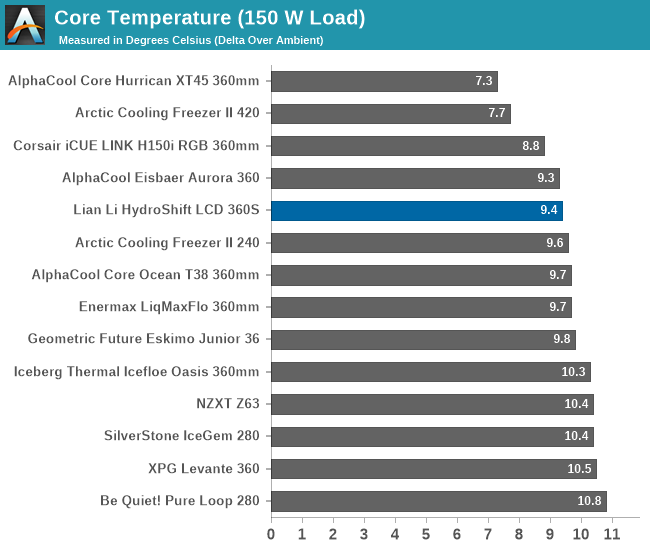
| Core Temperature, Constant Thermal Load (Max Fan Speed) |
The Lian Li HydroShift LCD 360S exhibits impressive performance across different load scenarios. At its maximum fan speed of 2490 RPM, it achieves an average thermal resistance of 0.063 °C/W. This performance ranks it among the top contenders in our charts, surpassed only by larger and more complex open-loop cooling systems. The cooler maintains its thermal efficiency consistently, even under varying demands. However, it is also important to note that the maximum fan speed is relatively high compared to similar products in the market.
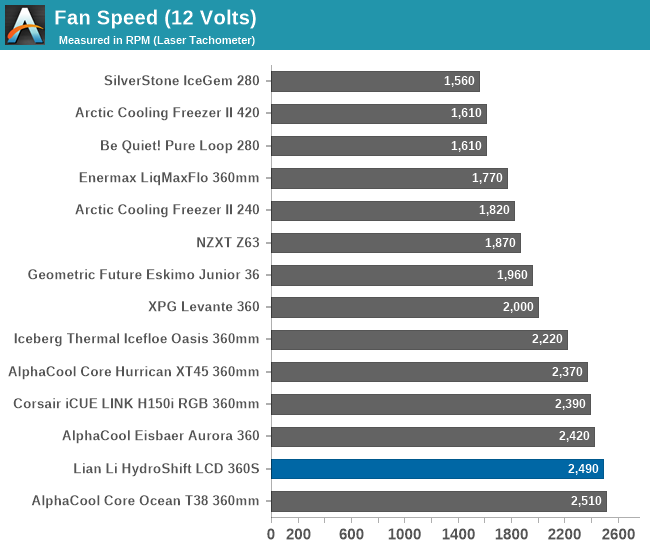
The Lian Li HydroShift LCD 360S, producing 47.1 dB(A) of noise at maximum fan speed, which is a little higher than expected even for a cooler with three high-performance 120mm fans. Additionally, the pump is powerful and can be easily heard if the fans are slowed down, contributing to an overall noise pressure level that tops our charts in the bad kind of way.

Using a PWM voltage regulator, we reduced the speed of the fans manually down to half their rated speed. At this setting, the 120 mm fans of the HydroShift 360S rotate at 1250 RPM.
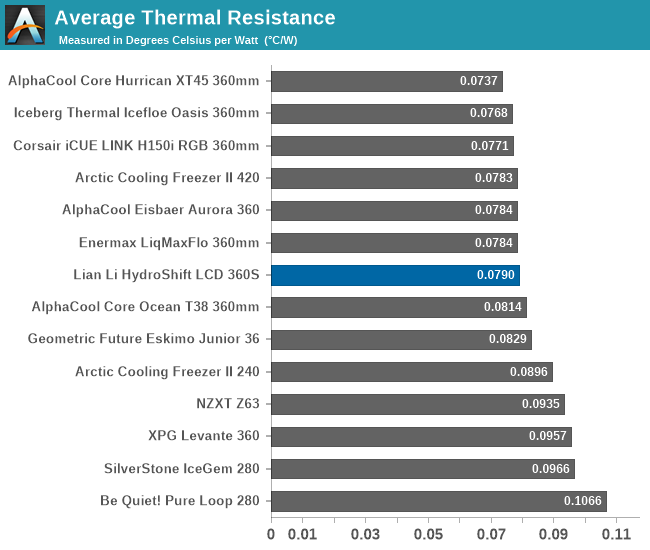
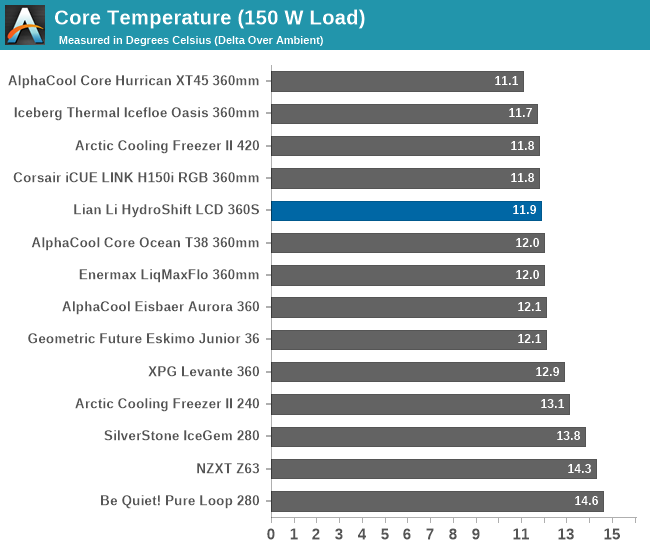
| Core Temperature, Constant Thermal Load (Low Fan Speed) |
The Lian Li HydroShift LCD 360S exhibits impressive cooling efficiency again, achieving an average thermal resistance of 0.079 °C/W with its fans operating at 1250 RPM. Its thermal performance is steady regardless of the load and the cooler is unfazed even at our highest load setting, suggesting that its cooling capacity is well beyond our testing station’s maximum capabilities. While this performance causes it to lose the top spot on our charts, it still remains one of the best performers available.
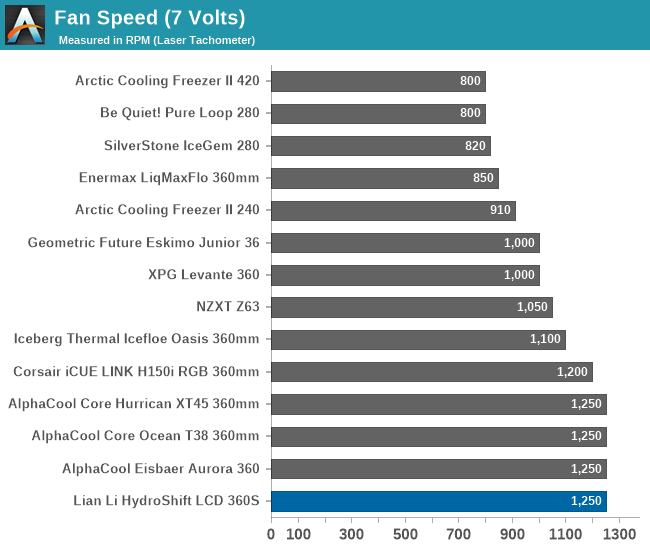
The acoustic performance at this lower fan speed is, once again, relatively poor. Even with the fans running at half speed, the cooler generates a relatively high noise level of 36.4 dB(A), positioning it as a noisier option compared to other three-fan cooling solutions. Despite this, we should remind that the HydroShift 360S offers a wide fan speed range, allowing users to adjust the fans down to as low as 200 RPM for quieter operation if desired.
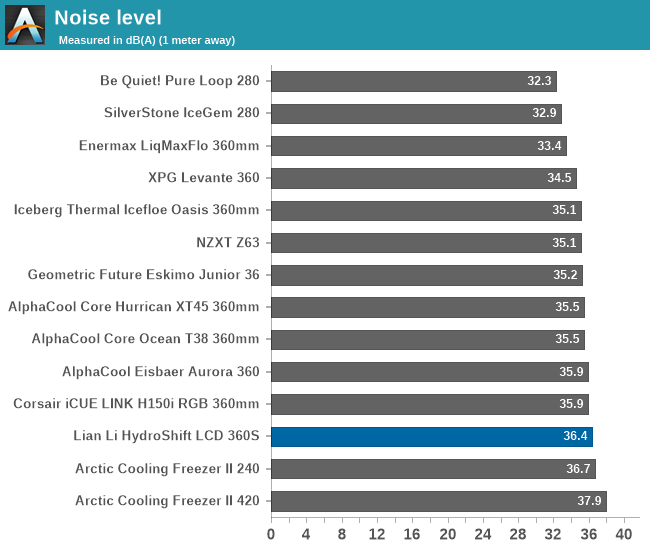
During our thermal resistance vs. sound pressure level test, we maintain a steady 100W thermal load and assess the overall performance of the coolers by taking multiple temperature and sound pressure level readings within the operating range of the stock cooling fans. The result is a graph that depicts the absolute thermal resistance of the cooler in comparison to the noise generated. For both the sound pressure level and absolute thermal resistance readings, lower figures are better.
This chart provides insightful details on the performance of the Lian Li HydroShift LCD 360S. It shows that the HydroShift 360S boasts a superior performance-to-noise ratio across its operational range compared to most competitive products, with the exception of the Enermax LiqMaxFlo. The Iceberg Thermal IceFLOE Oasis offers similar performance at low fan speeds, but the HydroShift 360S surpasses it as the load increases. While the cooler generates a relatively high amount of noise at its peak, its performance-to-noise ratio is excellent, making it a top contender in its class. We should remind that the HydroShift’s fans have a very wide operational range and can operate from as low as 200 RPM to as high as 2500 RPM, providing excellent versatility to users wanting to program their own cooling profiles.
For the marquee feature of the HydroShift LCD 360S cooler, which is the LCD screen, to function, users need to download and install Lian Li’s L-Connect 3 software. Once installed, the software will immediately discover the LCD if properly connected to an internal USB header. The UI is clean and simple, with five main tabs : System Info, Fan/Pump profiles, Quick/Sync Lighting, Hydroshift LCD, and Settings.
The first tab, System Info, is a purely informative tab that reads the system’s specs and sensors. Users cannot adjust anything here but it is useful for informational purposes, especially while trying to tune the fan/pump profiles. That brings us to the second tab, from which the users can select one of the pre-programmed cooling profiles or program their own. Some profiles, like the “Quiet” profile, are very conservative and will never run the unit at 100% capacity regardless of the CPU temperature.
The Quick/Sync Lighting tab is used to synchronize the cooler’s lighting with that of the system, assuming compatible components are installed. This is not particularly useful with the variation of the cooler we received for review because it does not feature RGB lighting, but Lian Li is also launching the HydroShift LCD 360RGB that features fans with RGB lighting, making this tab more relevant.
The HydroShift LCD tab is dedicated to the functions of the LCD display. Users can select one of the many pre-programmed visual effects or informative screens, or program their own. Users also have control over the screen’s brightness and they can import or export profiles, allowing them to share their designs and/or try someone else’s design.
Finally, the Settings tab has some basic options for the application itself. By default, the auto-run on boot setting is disabled, which can cause issues with the LCD screen as the app needs to be running for it to function properly. Users can change the temperature display from Celsius to Fahrenheit and vice-versa, view basic device info, and update the device firmware if available.
The Lian Li HydroShift LCD 360S is a well-engineered all-in-one liquid cooler that delivers on both performance and aesthetics, although the latter is certainly the primary marketing focus of this particular series. The HydroShift’s core design adheres to the traditional AIO setup, featuring a robust 360 mm radiator, durable braided hoses, and a sophisticated pump-block assembly – plus a “tubeless” aesthetic, formed via metallic braces and a plastic cover for the tubes, ensures a clean and professional look inside the case. The flexibility in mounting options, including the removable and repositionable aluminum plate with the Lian Li logo, allows users to customize the appearance to match their personal style and case layout. The standout feature of this cooler is undoubtedly its 2.88-inch IPS LCD screen, which can display custom graphics, animations, and detailed system information, making it a focal point in any PC build.
In terms of thermal performance, the HydroShift LCD 360S excels. At maximum fan speed, it achieves an impressive average thermal resistance of 0.063 °C/W, placing it among the top contenders in its class. This level of performance is typically seen only in more expensive and complex open-loop cooling systems. Even under varying loads, the cooler maintains consistent thermal efficiency, making it a reliable choice for very high-performance and overclocked builds. However, this high performance does come with a trade-off in noise levels, with the cooler producing 47.1 dB(A) at maximum fan speed, which is slightly higher than expected for a three-fan system, and consequently louder than other 360 mm coolers.
Dialed down to a more reasonable level, with its fans at half speed, the HydroShift achieves an average thermal resistance of 0.079 °C/W. While this performance causes it to lose the top spot on our charts, it remains one of the best performers available, demonstrating its capability to handle high thermal loads even at reduced fan speeds. The acoustic performance, however, remains a concern, with noise levels at 36.4 dB(A) even at half speed, making it one of the noisier options among similar coolers.
Given all of this, the saving grace for Lian’s Li design is the sheer range of the fans on the cooler. The fans have an incredibly wide operational range, stretching from as low as 200 RPM to as high as 2500 RPM, meaning it’s possible to dial in the cooler to anywhere between a roaring monster and a quiet field mouse, depending on a system’s needs. And all the while, for almost any point on the noise curve, the HydroShift is delivering performance that rivals or beats the best coolers on the markets today. So while the cooler is undeniably (and, perhaps, unfortunately) loud in its highest performance configuration, it still does very well for itself when dialed down to a more reasonable speed.
In conclusion, the Lian Li HydroShift LCD 360S stands out as a top-tier AIO cooler, offering a blend of high thermal performance, advanced features, and striking aesthetics. Its impressive cooling efficiency, wide operational range, and customizable LCD screen make it a compelling choice for enthusiasts seeking both functionality and style. While its out-of-the-box noise levels are going to be higher than some builders might prefer, the cooler’s overall performance-to-noise ratio is excellent, and the wide fan speed range offers the versatility needed for custom cooling profiles that can temper its fierce voice.
Otherwise, the launch price of $180 is reasonable when the LCD screen is taken into account, as similar competitive products retail for significantly more. Though by the same token, buyers who don’t find value in an LCD screen are going to find it harder to justify the price premium that it entails. But for those users who are looking to build a high-performance system with more than just a touch of modern flair, the HydroShift LCD 360S is a strong contender that does not disappoint.
